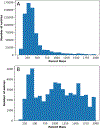Mass Spectrometry Adduct Calculator
- PMID: 34842435
- PMCID: PMC9529534
- DOI: 10.1021/acs.jcim.1c00579
Mass Spectrometry Adduct Calculator
Abstract
We describe the Mass Spectrometry Adduct Calculator (MSAC), an automated Python tool to calculate the adduct ion masses of a parent molecule. Here, adduct refers to a version of a parent molecule [M] that is charged due to addition or loss of atoms and electrons resulting in a charged ion, for example, [M + H]+. MSAC includes a database of 147 potential adducts and adduct/neutral loss combinations and their mass-to-charge ratios (m/z) as extracted from the NIST/EPA/NIH Mass Spectral Library (NIST17), Global Natural Products Social Molecular Networking Public Spectral Libraries (GNPS), and MassBank of North America (MoNA). The calculator relies on user-selected subsets of the combined database to calculate expected m/z for adducts of molecules supplied as formulas. This tool is intended to help researchers create identification libraries to collect evidence for the presence of molecules in mass spectrometry data. While the included adduct database focuses on adducts typically detected during liquid chromatography-mass spectrometry analyses, users may supply their own lists of adducts and charge states for calculating expected m/z. We also analyzed statistics on adducts from spectra contained in the three selected mass spectral libraries. MSAC is freely available at https://github.com/pnnl/MSAC.
Conflict of interest statement
The authors declare no competing financial interest.
Figures


References
-
- HolČapek M; Jirásko R; Lísa M Basic Rules for the Interpretation of Atmospheric Pressure Ionization Mass Spectra of Small Molecules. Journal of Chromatography A 2010, 1217, 3908–921. - PubMed
-
- Huang N; Siegel M; Kruppa G; Laukien F Automation of a Fourier Transform Ion Cyclotron Resonance Mass Spectrometer for Acquisition, Analysis, and E-Mailing of High-Resolution Exact-Mass Electrospray Ionization Mass Spectral Data. J. Am. Soc. Mass Spectrom. 1999, 10, 1166–1173.
-
- Fiehn O Mass Spectrometry Adduct Calculator. https://fiehnlab.ucdavis.edu/staff/kind/metabolomics/ms-adduct-calculator (accessed October 2021).
Publication types
MeSH terms
Grants and funding
LinkOut - more resources
Full Text Sources
Research Materials

